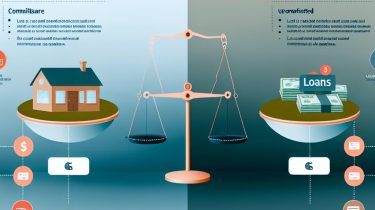Differences between secured and unsecured loans.

Understanding Secured and Unsecured Loans
When contemplating the option of taking out a loan, it is paramount to grasp the distinguishing factors between secured and unsecured loans. These distinctions can massively affect your financial commitments as well as the overall expense of borrowing.
Definition of Secured and Unsecured Loans
Secured loans are loans protected through collateral. Collateral acts as a safeguard for the lender, mitigating the risk associated with lending funds. If a borrower defaults on a secured loan, the lender is entitled to seize the collateral to recover the outstanding debt. Some prevalent examples of secured loans include mortgages and auto loans, wherein the house or car functions as the collateral.
Conversely, unsecured loans do not require collateral. Instead, these loans are based on the borrower’s credit history and ability to repay. Due to the absence of any asset to back the loan, unsecured loans often pose higher risks for lenders, consequently leading to elevated interest rates for borrowers. Personal loans and credit cards are common examples of unsecured loans.
Interest Rates
The interest rates tied to secured loans are typically lower than those linked to unsecured loans. This difference arises because the collateral diminishes the lender’s risk. For instance, mortgage interest rates are usually lower when compared to those of personal loans. The high-risk nature of unsecured loans, lacking any collateral, demands higher interest rates so that lenders can contend with the added risk.
Loan Amounts and Terms
Given that secured loans are backed by collateral, lenders generally show a higher willingness to offer larger amounts with extended repayment durations. Such arrangements afford borrowers the aptitude to handle substantial purchases, like acquiring a house or funding a vehicle, over a prolonged period. In contrast, unsecured loans typically offer smaller sums with shorter repayment schedules due to the lack of collateral.
Approval Process
The approval process for secured loans generally encompasses an evaluation of the collateral’s value, in addition to the borrower’s credit history and financial position. This process might prove more time-consuming compared to unsecured loans, which predominantly depend on the borrower’s credit report. Furthermore, secured loans might necessitate legal formalities, such as placing a lien, to be completed.
Risk and Consequences of Default
The repercussions of default differ notably between secured and unsecured loans. In the scenario of secured loans, the lender has the authority to repossess or foreclose on the collateral, possibly resulting in property loss or asset forfeiture for the borrower. On the other hand, with unsecured loans, the absence of collateral negates any immediate property loss. However, defaulting on unsecured loans can incur adverse effects such as detriment to the credit score, risk of legal action, and augmented challenges in obtaining further credit.
Conclusion
Comprehending the nuances between secured and unsecured loans is vital for making well-informed borrowing choices. While secured loans proffer lower interest rates and heightened borrowing limits, they entail the risk of losing assets upon default. Unsecured loans, despite offering greater flexibility and quicker approvals, often accompany higher interest rates and stricter borrowing limitations. For detailed guidance on which loan type aligns best with your financial requirements, it is prudent to consult financial resources or seek advice from a financial advisor.
In conclusion, a thorough understanding of these loan types provides borrowers with the tools necessary to navigate the complexities of financial lending. Such knowledge ensures that individuals are better equipped to make decisions that align with their financial goals and circumstances. Recognizing the subtle differences in these loan types and their implications empowers prospective borrowers to choose options that best suit their unique financial situations.
It is vital to reflect on both the short-term and long-term financial impacts when selecting between secured and unsecured loans. Secured loans, with their favorable terms, may provide a sense of security and stability for those willing to leverage their assets. Conversely, unsecured loans may appeal to those who prioritize quick access to funds without risking their personal assets.
The dynamics of secured and unsecured loans dictate that each choice should be made with comprehensive knowledge of one’s financial capacity, risk tolerance, and long-term goals. It is increasingly important to explore all available options, weigh the potential rewards, and assess the risks inherent in each loan type. In doing so, borrowers can ensure they are taking a loan conducive to their economic well-being and that supports their financial aspirations.
This article was last updated on: January 13, 2025